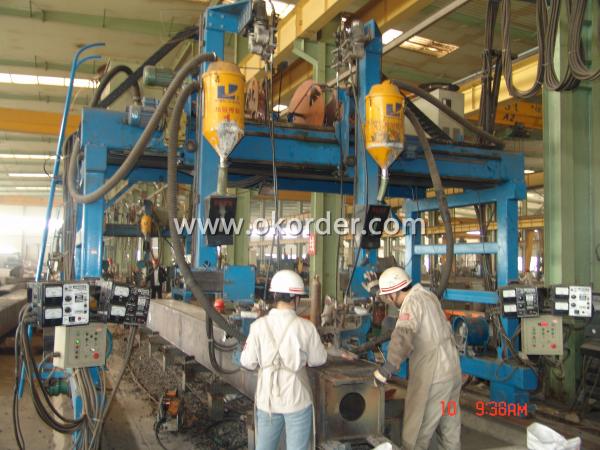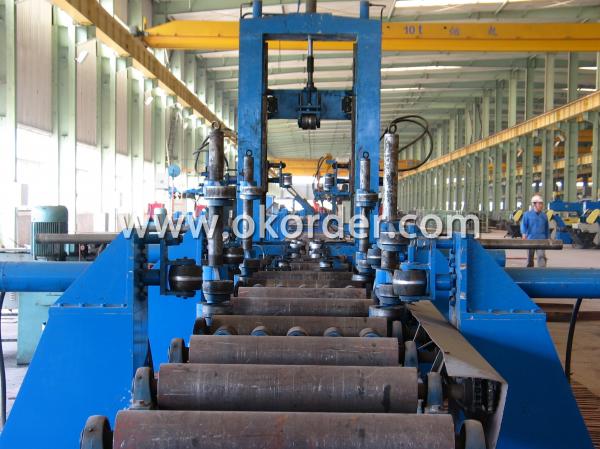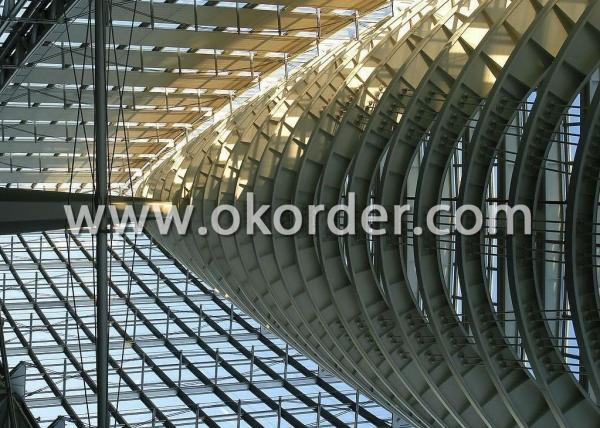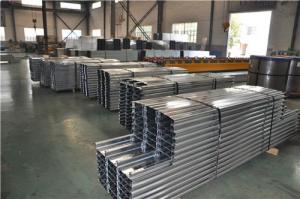Light Steel Structure Electric Plant
- Loading Port:
- Tianjin Port
- Payment Terms:
- TT or LC
- Min Order Qty:
- 10000 Square Meters m.t.
- Supply Capability:
- 50000 Square meters/Month m.t./month
OKorder Service Pledge
OKorder Financial Service
You Might Also Like
Specifications of light steel structure electric plant
Project type: light steel structure electric plant / electric workshop
The steel dosage: 2736MTs
Building area: 17600M2
The unit component weight: 18MTs
The span: 24m
|
Grade |
Chemical compositions | ||||
|
C |
Mn |
MAXIMUM(≤) | |||
|
Si |
S |
P | |||
|
Q345B |
≤0.2 |
1.00-1.60 |
0.55 |
0.04 |
0.04 |
|
Mechanical Properties | |||||
|
Yield point |
tensile strength |
Elongation | |||
|
16mm max |
16-40mm | ||||
|
345 |
325 |
470-630 |
21 | ||
1. GB standard material
2. High Structural safety and reliability
3. The production can reach GB/JIS/ISO/ASME standard
Packaging & Delivery of light steel structure electric plant
1. According to the project design and the component size, usually the main component parts are nude packing and shipped by bulk vessel. And the small parts are packed in box or suitable packages and shipped by containers.
2. This will be communicated and negotiated with buyer according to the design.
Engineering Design Software of light steel structure electric plant
Tekla Structure \ AUTO CAD \ PKPM software etc
⊙Complex spatial structure project detailed design
⊙Construct 3D-model and structure analysis. ensure the accuracy of the workshop drawings
⊙Steel structure detail ,project management, automatic Shop Drawing, BOM table automatic generation system.
⊙Control the whole structure design process, we can obtain higher efficiency and better results
Technical support of light steel structure electric plant
|
Worker |
Rate of frontline workers with certificate on duty reaches 100% |
|
Welder |
186 welders got AWS & ASME qualification 124 welders got JIS qualification 56 welders got DNV &BV qualification |
|
Technical inspector |
40 inspectors with UT 2 certificate 10 inspectors with RT 2 certificate 12 inspectors with MT 2 certificate 3 inspectors with UT3 certificate |
|
Engineer |
21 engineers with senior title 49 engineers with medium title 70 engineers with primary title. 61 First-Class Construction Engineers 182 Second-Class Construction Engineers |
|
International certification |
10 engineers with International Welding engineer, 8 engineers with CWI. |
Production Flow of light steel structure electric plant
Material preparation—cutting—fitting up—welding—component correction—rust removal—paint coating—packing—to storage and transportation (each process has the relevant inspection)
light steel structure plant welding light steel structure plant fitting-up
Usage/Applications of steel structure


*Characters of Structure Steel
1. Steel is characterized by high strength, light weight, good rigidity, strong deformation capacity, so it is suitable for construction of large-span, super high and super-heavy buildings particularly;
2. It with good homogeneous and isotropic, is an ideal elastomer which perfectly fits the application of general engineering;
3. The material has good ductility and toughness, so it can have large deformation and it can well withstand dynamic loads;
4. Steel structure’s construction period is short;
5. Steel structure has high degree of industrialization and can realize-specialized production with high level of mechanization.
*Steel structure application
1. Heavy industrial plants: relatively large span and column spacing; with a heavy duty crane or large-tonnage cranes; or plants with 2 to 3 layers cranes; as well as some high-temperature workshop should adopt steel crane beams, steel components, steel roof, steel columns, etc. up to the whole structure.
2. Large span structure: the greater the span of the structure, the more significant economic benefits will have by reducing the weight of the structure
3. Towering structures and high-rise buildings: the towering structure, including high-voltage transmission line towers, substation structure, radio and television emission towers and masts, etc. These structures are mainly exposed to the wind load. Besides of its light weight and easy installation, structure steel can bring upon with more economic returns by reducing the wind load through its high-strength and smaller member section.

4. Structure under dynamic loads: As steel with good dynamic performance and toughness, so it can be used directly to crane beam bearing a greater or larger span bridge crane
5. Removable and mobile structures: Structure Steel can also apply to movable Exhibition hall and prefabricated house etc by virtue of its light weight, bolt connection, easy installation and uninstallation. In case of construction machinery, it is a must to use structure steel so as to reduce the structural weight.
6. Containers and pipes: the high-pressure pipe and pipeline, gas tank and boiler are all made of steel for the sake of its high strength and leakproofness
7. Light steel structure: light steel structures and portal frame structure combined with single angle or thin-walled structural steel with the advantages of light weight, build fast and steel saving etc., in recent years has been widely used.
8. Other buildings: Transport Corridor, trestle and various pipeline support frame, as well as blast furnaces and boilers frameworks are usually made of steel structure.
All in all, according to the reality, structure steel is widely used for high, large, heavy and light construction..
- Q:What are the design considerations for steel religious buildings?
- Design considerations for steel religious buildings can vary depending on the specific needs and beliefs of the religious community. However, some common considerations include: 1. Aesthetic Appeal: Steel buildings can offer a sleek and modern look, but it is important to ensure that the design aligns with the religious community's aesthetic preferences. Attention should be given to the use of colors, architectural elements, and overall design to create a visually appealing space that reflects the religious values and traditions. 2. Functionality and Flexibility: Steel buildings provide versatility in terms of layout and design. The space should be designed to accommodate the religious rituals, ceremonies, and activities that will take place. Consideration should be given to the size and layout of the worship area, the inclusion of separate spaces for religious education or community gatherings, and the integration of necessary amenities such as restrooms, storage areas, and offices. 3. Acoustics: Sound plays a vital role in religious worship, so it is important to consider acoustics in the design of a steel religious building. Proper soundproofing and acoustic treatments can help create an environment with clear and balanced sound, ensuring that sermons, prayers, and musical performances are heard and understood by the congregation. 4. Sustainability: Environmental considerations should be taken into account in the design of steel religious buildings. Sustainable design elements such as energy-efficient lighting, insulation, and HVAC systems can help reduce energy consumption and lower operating costs. Additionally, incorporating renewable energy sources like solar panels can further enhance the building's sustainability. 5. Accessibility and Inclusivity: Religious buildings should be designed to accommodate people of all abilities. This includes providing accessible entrances, ramps, and elevators, as well as ensuring that seating areas and facilities are easily accessible for individuals with mobility challenges. Attention should also be given to creating inclusive spaces that cater to diverse worship practices and cultural traditions. 6. Safety and Security: Ensuring the safety and security of the congregation is paramount. Steel buildings offer inherent durability and strength, but additional measures such as fire safety systems, emergency exits, and security measures should be incorporated into the design. It is also important to comply with local building codes and regulations to ensure the safety of the facility. In summary, the design considerations for steel religious buildings encompass aesthetic appeal, functionality, acoustics, sustainability, accessibility, inclusivity, and safety. By carefully considering these factors, religious communities can create spaces that not only serve their spiritual needs but also contribute to the overall well-being and growth of their congregations.
- Q:What factors affect the cost of a steel structure?
- Several factors can affect the cost of a steel structure. These include the size and complexity of the structure, the type and quality of steel used, the location and accessibility of the construction site, the availability and cost of labor, as well as any additional features or customization required. Other factors such as market conditions, transportation costs, and regulatory requirements may also influence the overall cost of a steel structure.
- Q:How do steel structures contribute to the overall architectural heritage of a building?
- Steel structures contribute to the overall architectural heritage of a building in several ways. Firstly, steel offers a high level of structural integrity, allowing architects to design buildings with large open spaces, unique shapes, and impressive heights. This flexibility allows for the creation of iconic structures that become landmarks and symbols of a city or region's architectural identity. Furthermore, steel structures often have a sleek and modern aesthetic appeal. The use of steel beams, columns, and frames can create a visually striking contrast to other building materials, such as concrete or glass. This juxtaposition of materials adds to the overall architectural beauty and uniqueness of a structure. In addition, steel structures are known for their durability and longevity. Unlike other materials, steel is resistant to corrosion, pests, and fire. This durability ensures that steel buildings can withstand the test of time and remain standing for generations. As a result, they become an integral part of a city's architectural heritage, representing the craftsmanship and engineering prowess of the era in which they were built. Moreover, steel structures allow for efficient construction processes. The use of prefabricated steel components can significantly reduce construction time and costs. This efficiency not only benefits the builders but also contributes to the preservation of historical architecture. With shorter construction periods, less disruption is caused to the surrounding environment and existing structures, making it easier to incorporate steel elements into heritage buildings or conservation areas. Lastly, steel structures have the advantage of being easily adaptable and modifiable. This adaptability allows for future expansions, renovations, or repurposing of a building without compromising its structural integrity. It enables architects and designers to transform existing steel structures into new functional spaces, bringing new life to historical buildings and adding to their architectural heritage. In conclusion, steel structures contribute to the overall architectural heritage of a building by providing structural integrity, aesthetic appeal, durability, efficient construction processes, and adaptability. These qualities make steel an essential material in creating iconic, visually striking, and long-lasting structures that become an integral part of a city or region's architectural identity and heritage.
- Q:What are the design considerations for steel hospitals?
- Some of the key design considerations for steel hospitals include structural integrity, fire resistance, infection control, flexibility for future expansions or modifications, seismic resilience, and efficient space utilization. Additionally, the design should prioritize patient comfort, easy navigation for staff and visitors, adequate natural lighting and ventilation, as well as sustainability and energy efficiency.
- Q:What are the considerations for the design of steel structures in high-wind areas?
- When designing steel structures in high-wind areas, several considerations need to be taken into account. Firstly, the structural loadings from the wind, such as wind speed and direction, need to be carefully analyzed and factored into the design. The potential effects of gusts, turbulence, and wind-driven debris also need to be considered. Secondly, the shape and geometry of the structure play a crucial role in mitigating wind forces. Aerodynamic design features, such as streamlined profiles and tapered shapes, can help reduce wind resistance and minimize the potential for wind-induced vibrations. Thirdly, the selection of appropriate materials and construction methods is essential. High-strength steel with excellent ductility and fatigue resistance is typically preferred for withstanding wind loads. The fabrication and erection processes should adhere to rigorous quality control measures to ensure the structural integrity of the steel elements. Additionally, the connections between various structural components must be carefully designed to resist wind-induced loads. Properly designed and robust connections can enhance the overall stability and load distribution within the structure. Finally, it is essential to consider the effects of wind on the surrounding environment. Factors such as topography, nearby buildings, and vegetation can influence wind patterns and loads on the structure. Therefore, a comprehensive understanding of the local wind conditions is crucial for accurate and efficient design. Overall, the design of steel structures in high-wind areas requires a combination of thorough analysis, appropriate material selection, aerodynamic considerations, and careful attention to connections and site-specific conditions.
- Q:How are steel structures designed to withstand dynamic loading from moving vehicles?
- Steel structures are designed to withstand dynamic loading from moving vehicles through careful analysis and engineering. This involves considering factors such as the weight and speed of the vehicles, the impact forces generated, and the structural response to these forces. Various design techniques, such as using appropriate structural members and connections, employing dynamic analysis methods, and incorporating safety factors, are utilized to ensure that the steel structure can withstand and safely distribute the loads imposed by moving vehicles.
- Q:How are steel structures designed for wind uplift loads?
- Steel structures are designed for wind uplift loads by considering various factors such as the wind speed and direction, the shape and height of the structure, and the location of the structure. Engineers use wind load calculations and computer simulations to determine the maximum wind uplift forces that the structure may experience. Based on these calculations, they design the steel structure with appropriate connections, braces, and reinforcements to ensure its stability and resistance against wind uplift loads.
- Q:How are steel structures designed and constructed to meet sustainability objectives?
- Steel structures can be designed and constructed to meet sustainability objectives through various approaches. Firstly, the use of recycled steel helps reduce the need for virgin materials and minimizes the environmental impact of mining and manufacturing processes. Additionally, steel structures can incorporate efficient insulation systems, energy-saving features, and renewable energy technologies to optimize energy consumption and reduce greenhouse gas emissions. Moreover, the design can focus on maximizing natural lighting, ventilation, and the use of sustainable materials, further enhancing the overall sustainability of the structure. Lastly, careful planning and design considerations can ensure that the structure is durable, adaptable, and easily maintainable, reducing the need for frequent repairs or replacements and ultimately minimizing waste generation.
- Q:How do steel structures perform in high winds?
- Steel structures generally perform very well in high winds. Due to their high strength and rigidity, steel is an ideal material for withstanding strong winds and extreme weather conditions. The inherent properties of steel, such as its high tensile strength and ductility, allow it to effectively resist the forces exerted by wind loads. Steel structures are designed to be inherently stable and able to distribute the wind loads evenly throughout the structure. This is achieved through the use of appropriate bracing and cross-sectional shapes that can effectively dissipate the wind forces. The design of steel structures also takes into account factors such as wind direction, wind speed, and the specific location of the structure to ensure optimal performance. Steel buildings are often designed to have a certain amount of flexibility, allowing them to absorb and dissipate the energy generated by high winds. The ability to flex and deform under wind loads helps to minimize the risk of structural damage or failure. Additionally, steel structures usually have a low weight-to-strength ratio, which means they offer less resistance to the wind, resulting in reduced wind pressure. Moreover, steel structures can be further enhanced for high wind performance through the use of additional features such as aerodynamic shapes, wind deflectors, and streamlined designs. These measures help to reduce wind turbulence and prevent the formation of vortices, which can increase the wind forces acting on the structure. Overall, steel structures have a proven track record of performing well in high winds. Their stability, strength, and flexibility make them a reliable choice for areas prone to strong winds or extreme weather conditions. However, it is essential to ensure that the steel structure is designed and constructed by professionals following the necessary codes and standards to ensure its safety and performance in high winds.
- Q:How are steel structures designed to resist snow and ice accumulation?
- Steel structures are designed to resist snow and ice accumulation through a combination of careful engineering and the use of specific design features. The primary goal is to ensure that the structure can safely support the weight of the accumulated snow and ice without any risk of collapse or structural failure. One of the key design considerations is the determination of the snow load that the structure is likely to experience. This involves analyzing factors such as the geographical location, the average snowfall in the area, and the maximum expected snow depth. Based on this information, engineers can calculate the maximum expected weight of the snow and ice that the structure will need to support. To distribute this load evenly, the structural elements of the steel structure are typically designed to be stronger and heavier than necessary for normal loads. This ensures that the structure has a sufficient safety margin to handle the additional weight of snow and ice. In addition to these general design considerations, steel structures also incorporate specific features to resist snow and ice accumulation. For example, roofs are often designed with a steeper slope to allow for quicker shedding of snow and ice. This helps to prevent excessive buildup and reduces the load on the structure. Furthermore, some steel structures may include heating systems to melt snow and ice. This is particularly common in areas with heavy snowfall, where it is crucial to prevent excessive accumulation. These heating systems can be installed in strategic locations, such as on roofs or on critical structural members, to ensure the safe and efficient removal of snow and ice. Regular inspection and maintenance are also essential to ensure the ongoing resistance of steel structures to snow and ice accumulation. Inspections can identify any signs of damage, such as corrosion or weakening of structural elements, which may compromise the structure's ability to withstand the additional load. Overall, the design of steel structures to resist snow and ice accumulation involves a careful consideration of the expected load, the use of robust structural elements, the inclusion of specific design features, and regular inspections. By implementing these measures, steel structures can safely withstand the weight of snow and ice and ensure the integrity and longevity of the overall structure.
1. Manufacturer Overview |
|
|---|---|
| Location | SHANDONG,China |
| Year Established | 2008 |
| Annual Output Value | Above US$20 Billion |
| Main Markets | WEST AFRICA,INDIA,JAPAN,AMERICA |
| Company Certifications | ISO9001:2008;ISO14001:2004 |
2. Manufacturer Certificates |
|
|---|---|
| a) Certification Name | |
| Range | |
| Reference | |
| Validity Period | |
3. Manufacturer Capability |
|
|---|---|
| a)Trade Capacity | |
| Nearest Port | TIANJIN PORT/ QINGDAO PORT |
| Export Percentage | 0.6 |
| No.of Employees in Trade Department | 3400 People |
| Language Spoken: | English;Chinese |
| b)Factory Information | |
| Factory Size: | Above 150,000 square meters |
| No. of Production Lines | Above 10 |
| Contract Manufacturing | OEM Service Offered;Design Service Offered |
| Product Price Range | Average, High |
Send your message to us
Light Steel Structure Electric Plant
- Loading Port:
- Tianjin Port
- Payment Terms:
- TT or LC
- Min Order Qty:
- 10000 Square Meters m.t.
- Supply Capability:
- 50000 Square meters/Month m.t./month
OKorder Service Pledge
OKorder Financial Service
Similar products
New products
Hot products
Hot Searches
Related keywords



























